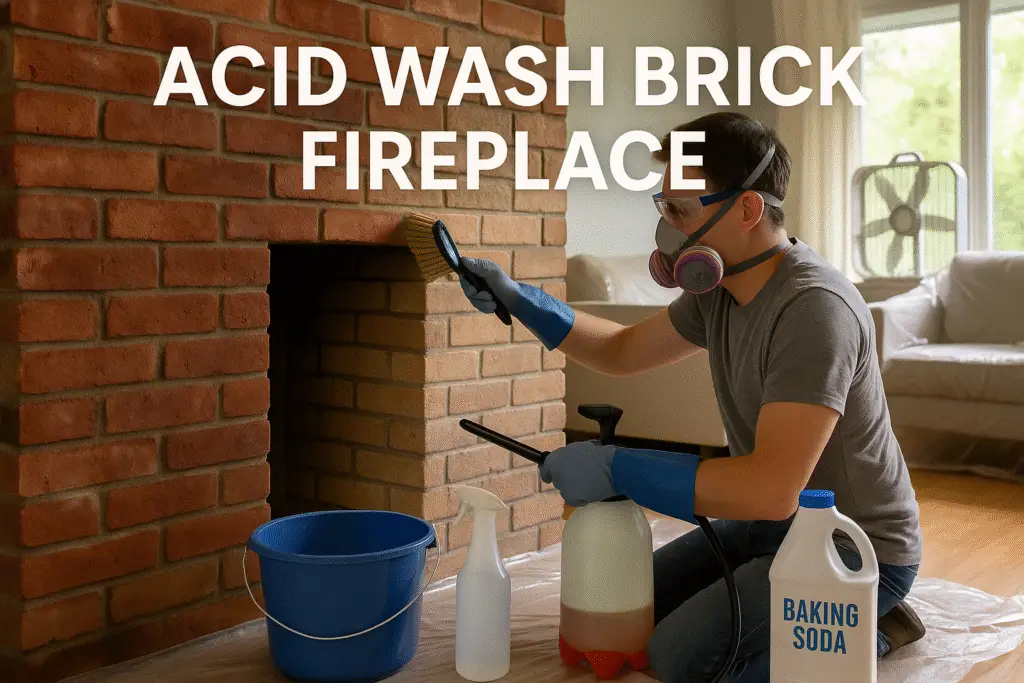Acid washing is a chemical treatment that removes years of soot, stains, and discoloration from brick fireplaces while lightening the brick’s color and revealing its natural texture. This process uses diluted acid solutions to dissolve surface deposits and partially break down the brick’s outer layer. Homeowners with dingy, dated brick fireplaces can achieve a refreshed, brighter appearance without complete renovation. Safety precautions are critical when working with acid indoors.
What is Acid Washing a Brick Fireplace? (Definition & Expected Results)
Acid washing is a chemical treatment process that uses diluted acid solutions to remove stains, soot, and discoloration from brick surfaces while simultaneously lightening the brick’s color and revealing its natural texture. The acid reacts with compounds in the brick to dissolve built-up residue and partially break down the outermost layer of the brick itself.
Not all brick responds the same way to acid treatment. Results vary based on:
- Brick composition: Clay bricks respond differently than concrete or manufactured brick
- Original color: Red brick typically lightens to a soft pink or orange-pink tone
- Age and porosity: Older, more porous brick absorbs more acid and shows more dramatic results
- Amount of soot/staining: Heavily soiled surfaces show more dramatic before/after contrast
Acid washing can effectively:
| Photo | Popular Air Purifiers | Price |
|---|---|---|

|
Air Purifiers for Home Large Room up to 1500ft², Tailulu H13 True HEPA Air Purifier for Pets Dust Odor Smoke, Air Purifier for Bedroom with 15dB Quiet Sleep Mode for Bedroom Office Living Room | Check Price On Amazon |

|
Afloia Air Purifier for Home, 4-in-1 Washable Filter for Allergies, Covers Up to 1076 ft², Quiet Operation, Auto Shut-Off & Night Light, Removes Pet Dander, Pollen, Dust, Mold, and Smoke, White,Pluto | Check Price On Amazon |

|
Nuwave OxyPure ZERO Air Purifier with Washable and Reusable Bio Guard Tech Air Filter, Large Room Up to 2002 Ft², Air Quality Monitor, 0.1 Microns, 100% Capture Irritants like Smoke, Dust, Pollen | Check Price On Amazon |

|
Air Purifiers for Home Large Room Up to 1,996 Ft², EOEBOT Air Purifier for Home Pets with Washable Filter, Quiet Sleep Mode, Air Quality Monitor, Air Purifier for Bedroom, Pet Hair, Dust, Smoke, White | Check Price On Amazon |

|
Afloia 2 IN 1 Air Purifier with Humidifier Combo, 3-Stage Filters for Home Allergies Pets Hair Smoker Odors, Evaporative Humidifier, Auto Shut Off, Quiet Air Cleaner with Seven Color Light,White | Check Price On Amazon |
- Remove years of soot buildup from fireplace use
- Eliminate water stains and mineral deposits
- Create a lighter, brighter brick appearance
- Reveal natural brick texture hidden under grime
However, acid washing cannot:
- Repair cracked or damaged brick
- Fix crumbling mortar joints
- Change the fundamental texture of the brick
- Completely change dark brick to white (unlike painting)
Unlike simple cleaning which removes only surface dirt, acid washing actually alters the brick surface. It differs from whitewashing or German schmear which add material to create a new finish. Before considering this powerful technique, understanding safety precautions is essential.
Essential Safety Precautions for Acid Washing Brick
Working with acid solutions indoors requires strict safety protocols to protect yourself, your home, and the environment. These non-negotiable safety measures must be implemented before you begin any acid washing project.
Personal Protective Equipment
- Chemical-resistant gloves: Thick, acid-resistant rubber gloves that extend past your wrists
- Eye protection: Full-seal chemical splash goggles (not regular safety glasses)
- Respiratory protection: N95 mask at minimum; half-face respirator with acid gas cartridges recommended
- Protective clothing: Long sleeves, long pants, and closed-toe shoes
- Face shield: Additional protection when mixing acid solutions
Room Preparation
- Ventilation: Open all windows and set up cross-ventilation with fans
- Cover surfaces: Use plastic sheeting on floors, furniture, and adjacent walls
- Remove furniture: Clear the room of all movable items
- Cover vents: Prevent acid vapors from circulating through your home
- Secure the area: Keep children and pets away with barriers
First Aid Preparations
- Keep a neutralizing solution (baking soda mixed with water) nearby
- Have an emergency eyewash station or large containers of clean water accessible
- Post poison control number (1-800-222-1222) in your work area
- Work with a partner who can help in case of emergency
According to masonry restoration specialist Mark Johnson, “The most common acid washing injuries occur from inadequate ventilation and improper protective equipment. Never compromise on safety gear or proper room preparation—the risk isn’t worth it.”
Warning signs of inadequate ventilation include headache, dizziness, irritated eyes, or difficulty breathing. If you experience these symptoms, immediately leave the area for fresh air and reassess your ventilation setup before continuing.
For environmental safety, never dispose of acid or neutralized solutions down household drains. Contact your local hazardous waste facility for proper disposal guidelines. With safety protocols established, let’s gather the precise materials needed for a successful acid wash.
Materials and Tools Needed for Acid Washing
Gathering the right materials before beginning your acid wash project ensures efficiency and safety. This comprehensive list includes everything needed from preparation through completion.
Acid Options
- Muriatic acid: Most common option, strongest effect (31% hydrochloric acid solution)
- Phosphoric acid: Milder option, better for sensitive brick (gentler but requires more applications)
- Citric acid: Natural alternative, safest but least effective (requires higher concentration)
Mixing and Application Tools
- Acid-resistant plastic buckets: Never use metal containers
- Plastic measuring cups: For precise acid-to-water ratios
- Plastic spray bottles: For smaller areas or detail work
- Acid-resistant brushes: Natural bristle brushes work best
- Extension pole: For reaching higher areas safely
- Pump sprayer: For larger applications (must be acid-resistant)
Neutralizing and Testing Materials
- Baking soda: 2-3 pounds for neutralizing solution
- pH test strips: To verify neutralization
- Garden sprayer: For applying neutralizing solution
- Clean water supply: For mixing and rinsing
Preparation and Protection
- Plastic sheeting: 4-6 mil thickness for floor and surface protection
- Painter’s tape: For securing plastic and masking areas
- Cleaning supplies: Wire brush, vacuum, all-purpose cleaner for pre-cleaning
- Waterproof drop cloths: Additional floor protection
For a standard fireplace (approximately 25-30 square feet), expect to spend $75-150 on materials. Most items can be purchased at home improvement stores, though specialty masonry supply stores offer higher-quality acid-resistant brushes and appropriate safety equipment.
With all materials assembled, proper preparation of your workspace and brick surface is the next critical step.
Preparing Your Brick Fireplace for Acid Washing
Proper preparation of your brick fireplace ensures optimal results and prevents potential damage to surrounding surfaces. Follow these steps methodically before applying any acid solution.
Initial Cleaning
- Remove any fireplace screens, tools, or decorative items
- Vacuum the entire brick surface to remove loose soot and debris
- Scrub the brick with a wire brush to loosen embedded dirt
- Clean with a mild detergent solution and rinse thoroughly
- Allow the surface to dry completely (24-48 hours minimum)
Inspection and Protection
- Examine the brick and mortar for damage or crumbling
- Fill any cracks in the mortar with fireplace mortar patch and allow to cure
- Check for any metal elements embedded in the brick (these will react with acid)
- Cover metal elements with petroleum jelly to prevent reaction
- Apply painter’s tape to create clean edges around the fireplace
- Cover the floor with overlapping plastic sheeting, secured with tape
- Protect the mantel and hearth with plastic sheeting
Test Area Preparation
- Select an inconspicuous area for testing (usually a lower corner)
- Dampen the test area with clean water
- Apply a small amount of your acid solution
- Allow it to work for the planned duration
- Neutralize and rinse the test area
- Evaluate the results before proceeding with the full project
Common preparation mistakes include insufficient cleaning before application, inadequate drying time, and failure to protect surrounding surfaces properly. Spending extra time on preparation prevents most acid washing problems.
With preparation complete, the next step is correctly mixing your acid solution for your specific brick type.
Mixing the Proper Acid Solution for Different Brick Types
Different brick types require specific acid concentrations to achieve optimal results without damage. This section guides you through selecting the right acid type and concentration for your specific fireplace brick.
| Brick Type | Recommended Acid | Dilution Ratio (Acid:Water) | Working Time |
|---|---|---|---|
| Red Clay Brick (Traditional) | Muriatic Acid | 1:10 | 3-5 minutes |
| Older Porous Brick (Pre-1950s) | Muriatic Acid | 1:12 | 2-4 minutes |
| Modern Clay Brick | Muriatic Acid | 1:8 | 4-6 minutes |
| Concrete Brick | Muriatic Acid | 1:6 | 5-7 minutes |
| Sensitive/Historic Brick | Phosphoric Acid | 1:4 | 5-8 minutes |
| Painted Brick (Previous Finish) | Not Recommended | N/A | N/A |
Mixing Instructions:
- Put on all protective gear before opening acid containers
- Fill your plastic bucket with the appropriate amount of WATER FIRST
- Slowly add acid to water (NEVER water to acid)
- Stir gently with a plastic utensil
- Mix only what you need for immediate use
For a standard fireplace surround (approximately 30 square feet), prepare about 1 gallon of solution initially. Mixed solutions have a working life of approximately 4 hours before starting to lose effectiveness.
Signs of an improperly mixed solution include:
- Too strong: Excessive foaming upon application, rapid color change, visible etching
- Too weak: Little reaction, minimal cleaning effect, no visible change
When in doubt, start with a more diluted solution and increase concentration if needed. You can always make a solution stronger, but you cannot undo damage from a solution that’s too strong.
How to Identify Your Brick Type
Correctly identifying your brick type is crucial for selecting the appropriate acid concentration. Use this visual identification guide to determine your brick type before proceeding.
- Red Clay Brick: Uniform reddish color, smooth texture, standard rectangular shape
- Older Porous Brick: Often irregular in shape, varied coloration, more textured surface, may have small pits
- Modern Clay Brick: Very uniform in size and color, harder surface, less porous
- Concrete Brick: Heavier, often grayish undertone, more uniform texture, less variation in color
- Clinker Brick: Irregular shape, often darker in color with a “burnt” appearance, harder surface
Simple Brick Test: Place a few drops of water on the brick. If it absorbs quickly (under 1 minute), you likely have older, more porous brick. If water beads or takes several minutes to absorb, you have less porous modern brick or concrete brick.
Homes built before 1950 typically feature more porous, handmade brick varieties that require gentler acid concentrations. Modern homes (post-1970s) often have less porous, machine-made brick that can withstand slightly stronger solutions.
Once you’ve identified your brick type, refer to the table above for the exact acid concentration.
Step-by-Step Acid Washing Application Technique
The application process requires methodical technique to ensure even results and prevent damage. Follow these precise steps in order, working in small sections for best results.
- Dampen the surface: Thoroughly wet the brick with clean water using a spray bottle. Brick should be damp but not dripping wet. This critical step prevents the brick from absorbing too much acid.
- Apply to a small section: Using your brush or sprayer, apply acid solution to a 3×3 foot section, starting at the bottom and working upward. This prevents streaking from runoff.
- Light agitation: After 30 seconds, lightly brush the solution into the brick using a circular motion. Don’t scrub aggressively.
- Monitor reaction time: Watch for bubbling and color change. Most solutions need 3-7 minutes to work properly, depending on brick type and concentration.
- Test progress: After the minimum recommended time, test a small spot by neutralizing and rinsing. If results aren’t sufficient, reapply for an additional 1-2 minutes.
- Neutralize section: Apply the baking soda solution generously to the section you’ve just treated. The solution should stop bubbling.
- Rinse thoroughly: Using clean water, rinse the neutralized section completely.
- Move to adjacent section: Overlap slightly with the previous section to prevent visible lines.
- Complete entire surface: Continue the process until the entire fireplace is treated.
Tips for Specific Areas
- Mortar lines: Use a smaller brush for precise application in mortar joints
- Corners: Apply from both sides to ensure complete coverage
- Heavily soiled areas: May require a second application after the first treatment dries
- Uneven areas: Use a spray bottle for better coverage of textured surfaces
You’ll know the acid is working properly when you observe:
- Gentle foaming or bubbling
- Visible lightening of the brick color
- Loosening of surface dirt and stains
If you see excessive foaming, smoking, or very rapid color change, your solution is too strong. Immediately neutralize and rinse the area, then remix a more diluted solution.
Once the acid has done its work, immediate neutralization is critical to stop the chemical reaction and protect your brick.
Neutralizing the Acid: Critical Post-Application Steps
Neutralizing the acid solution is not optional—it’s essential to stop the chemical reaction and prevent ongoing damage to your brick. This process must be performed thoroughly and systematically.
Neutralizing Solution Preparation
- Mix 1 cup of baking soda per gallon of water in a clean garden sprayer or bucket
- Stir until completely dissolved
- Prepare enough to thoroughly saturate all treated areas
Neutralization Process
- Apply liberally: Thoroughly saturate all acid-treated surfaces with the baking soda solution
- Watch for reaction: The neutralization reaction may cause minor foaming as the acid is neutralized
- Wait 5 minutes: Allow the neutralizing solution to fully work
- Test pH: Use pH test strips on damp brick surface (should read 7-8, neutral)
- Repeat if necessary: If pH is below 7 (acidic), apply more neutralizing solution
Thorough Rinsing
- Rinse each section with clean water at least three times
- Use a clean sponge to wipe surfaces and collect excess water
- Pay special attention to crevices and mortar joints
- Final pH test after rinsing should read 7 (neutral)
Mason contractor Thomas Rivera warns: “Incomplete neutralization is the number one cause of brick deterioration after acid washing. Many DIYers rush this step, but the acid continues to subtly damage the brick for months if not properly neutralized.”
Signs of incomplete neutralization include:
- White powdery residue developing days after treatment
- Continued color changes in the brick
- Brittle or crumbling brick surface over time
- Acidic smell that persists after treatment
For disposal, never pour neutralized solutions down household drains. While neutralized, they still contain dissolved minerals and chemicals. Collect in sealed containers and dispose of according to local hazardous waste guidelines.
With the acid neutralized, these essential after-care steps will ensure your newly refreshed brick maintains its appearance.
After-Care and Maintenance for Acid-Washed Brick Fireplaces
Your newly acid-washed brick fireplace requires specific care to maintain its refreshed appearance. This maintenance timeline provides both immediate after-care and long-term preservation guidance.
Immediate After-Care (First 48 Hours)
- Allow the brick to dry completely (24-48 hours minimum)
- Maintain good ventilation in the room
- Do not touch or clean the brick during this period
- Avoid using the fireplace until fully cured
First Week Care
- Remove all protective coverings carefully
- Clean surrounding areas with normal household cleaners
- Gently vacuum any dust from the brick surface
- Consider applying a breathable brick sealer after 7 days
Ongoing Maintenance Schedule
- Weekly: Dust with a soft brush attachment on vacuum
- Monthly: Check for soot buildup if fireplace is in use
- Seasonally: Clean with mild soap and water solution
- Yearly: Inspect for stains or discoloration
- Every 3-5 Years: Consider reapplying sealer if used
Recommended Cleaning Products
- For routine cleaning: Mild dish soap and water
- For soot removal: TSP substitute cleaner
- For spot stains: Specific brick cleaners labeled for acid-washed surfaces
Products to Avoid
- Abrasive cleaners or brushes
- Bleach-based products
- Ammonia-based cleaners
- Pressure washers
- Acidic cleaning solutions
When properly maintained, acid-washed brick typically retains its refreshed appearance for 8-12 years before significant darkening or staining returns. Fireplaces that see regular use may need more frequent cleaning and care.
While acid washing is effective for many fireplaces, these alternative methods might be better suited to your specific situation or preferences.
Alternative Methods to Acid Washing: Comparing Options
Acid washing isn’t the only way to refresh a brick fireplace. This objective comparison of alternatives helps you determine if acid washing is truly the best approach for your specific situation.
| Method | Best For | Pros | Cons | Cost Range | Difficulty |
|---|---|---|---|---|---|
| Acid Washing | Heavily soiled brick, subtle color lightening | Reveals natural brick texture, removes deep stains | Chemical hazards, potential damage if done incorrectly | $75-150 DIY | Difficult |
| Whitewashing | Dramatic lightening while showing some brick texture | Safer than acid, adjustable opacity, easier to apply | Covers natural brick color, requires maintenance | $50-100 DIY | Moderate |
| German Schmear | Creating rustic, old-world look | Dramatic transformation, textural interest | Significantly changes appearance, not suitable for all decor | $100-200 DIY | Moderate |
| Brick Painting | Complete color change | Unlimited color options, highest coverage | Covers natural texture, difficult to reverse | $100-300 DIY | Easy |
| Professional Cleaning | Valuable/historic fireplaces | Safest for brick, professional results | Most expensive option, less dramatic change | $300-800 | N/A |
Environmental Considerations
- Acid Washing: Highest environmental impact, requires hazardous waste disposal
- Whitewashing: Medium impact, water-based options available
- German Schmear: Lower impact, primarily uses natural materials
- Painting: Medium impact, depends on paint type chosen
- Professional Cleaning: Varies by company and methods used
Reversibility Factor
- Acid Washing: Permanent, cannot be undone
- Whitewashing: Partially reversible with significant effort
- German Schmear: Difficult to reverse completely
- Painting: Very difficult to reverse
- Professional Cleaning: Non-invasive, no reversal needed
Consider your home’s style, your comfort with DIY projects, and your long-term plans when choosing a method. Historic homes may benefit from professional cleaning rather than acid washing to preserve original materials.
If you’ve decided to proceed with acid washing, being prepared for these common challenges will ensure success.
Troubleshooting Common Acid Washing Problems
Even with careful preparation, challenges can arise during the acid washing process. This troubleshooting guide addresses common issues with specific solutions.
Uneven Results
Problem: Some areas appear lighter than others, creating a patchy appearance.
Causes: Inconsistent application, varying brick porosity, or uneven acid contact time.
Solution:
- Allow brick to dry completely (48 hours minimum)
- Identify darker areas that need additional treatment
- Apply a slightly more diluted acid solution only to darker areas
- Use a feathering technique at the edges to blend
White Residue or Efflorescence
Problem: White powdery substance appears on brick days after treatment.
Causes: Incomplete neutralization or rinsing, dissolved minerals migrating to surface.
Solution:
- Mix 1 part white vinegar with 5 parts water
- Apply lightly to affected areas with a soft brush
- Rinse thoroughly with clean water
- Re-neutralize with baking soda solution
Over-Lightened Brick
Problem: Brick appears too light or washed out after treatment.
Causes: Solution too strong, contact time too long, or excessive agitation.
Solution:
- Allow to fully dry to assess final color (often darkens slightly)
- If still too light, consider applying a very diluted colorant specifically made for brick
- For severe cases, consider a tinted sealer to restore some color depth
Damage to Mortar Joints
Problem: Mortar appears eroded, crumbly, or excessively lightened.
Causes: Acid solution too strong for mortar type, excessive contact with mortar.
Solution:
- Allow to dry completely
- Remove any loose or damaged mortar
- Apply appropriate mortar repair product
- Consider tinting new mortar to match surrounding areas
Stubborn Stains Remain
Problem: Certain stains persist after acid washing.
Causes: Oil-based stains, metallic stains, or deeply embedded contaminants.
Solution:
- Identify stain type (oil, rust, organic)
- Apply appropriate stain-specific cleaner
- For oil stains: Use a poultice with acetone or mineral spirits
- For rust stains: Use a commercial rust remover designed for masonry
When dealing with acid washing problems, patience is key. Allow sufficient drying time between attempted fixes, as brick appearance can change significantly as it dries.
Professional mason John Weber advises: “If you’re uncertain about fixing an acid washing problem, consult a professional. Some repair attempts can actually make the situation worse, especially if the wrong products are used on damaged brick.”
Beyond these common issues, here are answers to the questions homeowners most frequently ask about acid washing brick fireplaces.
Frequently Asked Questions About Acid Washing Brick Fireplaces
These frequently asked questions address specific concerns about acid washing brick fireplaces that haven’t been covered in detail elsewhere in this guide.
Is acid washing safe for all brick fireplaces?
No. Acid washing is not recommended for painted brick, certain manufactured brick types, or historic brick (pre-1900). Painted surfaces must be stripped first, and some synthetic brick can be damaged by acid. Always test in an inconspicuous area first.
How long does the acid washing process take from start to finish?
The complete process typically takes 2-3 days. Day 1: Preparation and initial cleaning. Day 2: Acid application and neutralization. Day 3: Final cleanup and assessment. Allow additional drying time before using the fireplace again.
Can I acid wash just part of my fireplace?
This is not recommended. Partial treatment almost always results in visible differences between treated and untreated areas. For consistent results, treat the entire fireplace surface.
Will acid washing affect the structural integrity of my fireplace?
When done properly, acid washing should not affect structural integrity. However, repeated acid washing or using too strong a solution can weaken brick and mortar over time. This is why proper dilution and complete neutralization are critical.
How much does professional acid washing cost compared to DIY?
Professional acid washing typically costs $500-1,000 for a standard fireplace, while DIY materials cost $75-150. However, professionals bring experience, proper equipment, and assume liability for any damage.
Can I acid wash the mortar as well as the brick?
Yes, but mortar is more susceptible to acid damage than brick. Most professionals use a slightly more diluted solution and minimize contact time with mortar joints. Consider applying petroleum jelly to protect mortar if you want to minimize its lightening.
Are there any building codes or regulations regarding acid washing?
Most areas don’t have specific codes for acid washing, but many municipalities have regulations regarding chemical use and disposal. Check with your local building department and waste management facility for specific requirements.
Final Considerations and Expert Advice
Before beginning your acid washing project, consider this final expert advice and important reminders to ensure success and safety.
- Always prioritize safety: No aesthetic improvement is worth risking your health. Use all recommended protective equipment without exception.
- Start with the gentlest solution: According to masonry restoration specialist David Miller, “The most common DIY mistake is using solutions that are too strong. You can always increase concentration gradually if needed.”
- Consider seasonal timing: Spring and fall provide ideal temperatures and ventilation conditions for indoor chemical work.
- Document your process: Take notes on your specific mixture, timing, and results for future reference or touch-ups.
- Be realistic about results: Acid washing lightens and refreshes—it doesn’t transform dark brick to white brick.
When to Choose Professional Help
Consider hiring a professional if:
- Your fireplace has historical value
- You have respiratory conditions or chemical sensitivities
- Your fireplace has previous damage or repairs
- You’re uncomfortable handling hazardous chemicals
- Your fireplace is unusually large or architecturally complex
With proper preparation, appropriate safety precautions, and careful technique, acid washing can transform a dated, sooty brick fireplace into a refreshed focal point that enhances your entire room. The key to success lies in respecting the power of the chemicals you’re using and following each step methodically.






